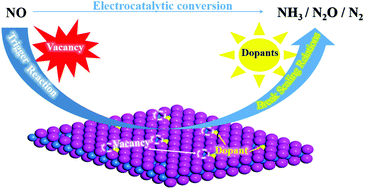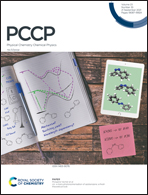Vacancy-triggered and dopant-assisted NO electrocatalytic reduction over MoS2†
Abstract
Nitric oxide electroreduction reaction (NOER) is an efficient method for NH3 synthesis and NOx-related pollutant treatment. However, current research on NOER catalysts mainly focuses on noble metals and single atom catalysts, while low-cost transition metal dichalcogenides (TMDCs) are rarely considered. Herein, by applying density functional theory (DFT) calculations, we study the catalytic performance of NOER over 2H-MoS2 monolayers with the most common S vacancies and some Mo atoms substituted by transition metal atoms (denoted as TM-MoS2@VS). Our results show that an S vacancy and a heteroatom substitution tend to form a first nearest neighbour (1NN) pair, which greatly improves the NOER catalytic performance of 2H-MoS2. The S vacancy site can trigger NOER by strongly adsorbing a NO molecule and elongating the NO bond, while the heteroatom dopant can assist NOER by tuning the electron donating capability of 2H-MoS2 which breaks the linear scaling relations among key reaction intermediates. At low NO coverage, NH3 can be correspondingly yielded at −0.06 and −0.38 V onset potentials over the Pt- and Au-doped MoS2 catalysts with S vacancies (Pt-MoS2@VS and Au-MoS2@VS). At high NO coverage, N2O/N2 is thermodynamically favored. Meanwhile, the competing hydrogen evolution reaction (HER) is suppressed. Thus, the Pt-MoS2@VS catalysts are promising candidates for NOER. In addition, coupling the substitutional doping of Mo atoms to S vacancies presents great potential in improving the catalytic activity and selectivity of MoS2 for other reactions. In general, the strategy of coupling hetero-metal doping and chalcogen vacancy can be extended to enhance the catalytic activity of other TMDCs.



 Please wait while we load your content...
Please wait while we load your content...